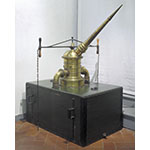This type of pump - also known as idrobalo - was invented c. 1785 by the Milanese provost Carlo Castelli, who called it a "hydraulic fan" [ventilatore idraulico] for its resemblance to fan systems used in mines. Indeed, the pump lacks pistons and rotating parts, but operates by means of a moving compartment. It is fastened to a large varnished wooden case with two removable covers that serves as a water tank. The machine body consists of a large brass cylinder topped by a spherical dome that carries a horizontally-moving handle. A long nozzle-tipped pipe is screwed diagonally to the dome. Two water-intake tubes lead out from either side of the pump into the tank through cord-covered leather sleeves. The pump body is internally divided by a pair of prism-shaped panels fitted with valves. When the handle is rotated, it activates a moving partition hinged vertically between the panels. The movement of the panel draws water from the tank on one side and drives it toward the upper dome and the pipe. The dome also acts as an air chamber to maintain a constant pressure. Such pumps were used for irrigation, drawing water from wells, and firefighting. The specimen displayed here was built in the workshop of the Museo di Fisica e Storia Naturale of Florence between 1793 and 1794.










